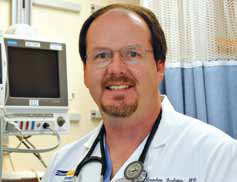Find care now
If you are experiencing a medical emergency, please call 911 or seek care at an emergency room.

By Brendan Furlong, MD, Chief of Service, Emergency Department, MedStar Georgetown University Hospital
The statistics are staggering: More than three-quarters of a million people in the United States experience a stroke each year, according to the Centers for Disease Control and Prevention (CDC), and one American dies from a stroke every 4 minutes, on average.
With those numbers, it’s easy to understand why the CDC, the National Stroke Association (NSA) and others say that every minute counts when it comes to stroke diagnosis and treatment.
What is a stroke?
During a stroke, blood flow to an area of the brain is cut off so brain cells lose oxygen and begin to die. As a result, bodily functions controlled by that area of the brain, such as memory and muscle movement, can be damaged.
The most common strokes are:
- Ischemic strokes: When the artery that supplies blood to the brain becomes blocked. Blood clots are a major cause of blockages that lead to ischemic strokes.
- Hemorrhagic strokes: Whenan artery in the brain leaks blood or ruptures, causing excessive pressure that damages brain cells. Conditions that cause a hemorrhagic stroke include high blood pressure and aneurysms.
A transient ischemic attack (TIA) is the temporary interruption of blood flow to the brain, causing neurologic deficits. When the blood supply is restored, the deficits resolve. A TIA can serve as a warning sign of an impending stroke and should be treated as seriously as a stroke.
Who is at risk?
Age is an important risk factor for stroke. Although anyone can experience a stroke, the chance of having one nearly doubles every 10 years after age 55. Men are more likely to experience stroke than women, but women are more likely to die from stroke.
Know the signs
It’s important to recognize the signs and symptoms of a stroke. In both men and women, according to the CDC, a stroke may appear as:
- Sudden numbness or weakness in the face, arm or leg, especially on one side of the body
- Confusion or difficulty speaking
- Trouble seeing in one or both eyes
- Inability to walk, dizziness, loss of balance or lack of coordination
- Severe headache with no known cause

Stroke Prevention
The key to stroke prevention is to understand and manage your risks. Some causes of stroke, such as genetics and family history, cannot be controlled. But you can take steps to manage many common medical conditions that increase your risk, including:
- High blood pressure
- High cholesterol
- Heart disease
- Atrial fibrillation
- Diabetes
Managing these conditions and making healthy choices—eating a nutritious diet, maintaining a healthy weight, exercising regularly, not smoking and limiting alcohol consumption—can help prevent stroke.
If you or someone else experiences any symptoms of stroke, call 911 immediately and get to a specialized stroke center, if possible. Prompt emergency care, whether to prevent another stroke or treat side effects of stroke, can ensure the quickest possible diagnosis and treatment.
Make an Appointment
For more information or to schedule an appointment with a stroke specialist, call our scheduling line:
Learn More
Act FAST
The FAST acronym, standing for “Face, Arms, Speech, Time” can improve detection and prompt treatment for stroke.















